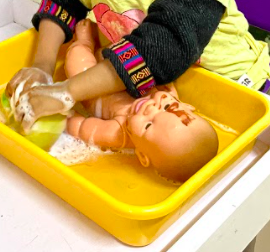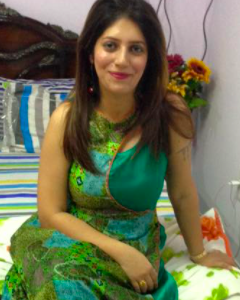When children are active participants in their own learning, then the whole process of education is much more than just rote memorization. The child centered constructivist approach helps to ignite child’s curiosity and love for learning. The role of facilitator is to create learning opportunities and to be a guide in children’s learning as they develop their own inquiries by not dictating the learning objectives.

By Garima Srivastava
“We as facilitators were really thinking through what the initial provocation for our unit could be, considering we were in a pandemic situation and our sessions were virtual.”
In Early Years, inquiry is facilitated by play based learning, where the whole process is designed to keep child at the center. Children are tuned into their inquiry through initial provocation, which then ignites their curiosity. This is followed by giving them space, time, opportunities to assess, explore, assimilate and accommodate their previous knowledge with the newly acquired knowledge.
In Pre-Nursery we started a new unit with the central idea: ‘Things around us grow and change.’ We as facilitators were really thinking through what the initial provocation for our unit could be, considering we were in a pandemic situation and our sessions were virtual. It was very important for us to plan the tuning in sessions to be interesting, exciting and catering to the child’s immediate environment (as the children were at home). So, we began the unit by asking our parent community to setup the provocation corner in different rooms of the house for the first week.
Week-1 Observing spaces
We started by observing different spaces children see in their homes like kitchen, bedroom, patio. It was very important for us to frame the right kind of questions based on the spaces in observation to ignite the curiosity of children. Questions like
- Where are we sitting for our session today?
- Why are we sitting here?
- What can you all see in your surrounding?
These initial provocation questions did help our young learners to observe their immediate environment and talk about it.
We as facilitators had to give enough time and space to let the inquiry unfold gradually rather than using the lines of inquiry pre-decided by us dictating the whole process. It was a conscious decision by the team to let the inquiry converge slowly to the central idea. After our successful week-1 into the unit where children at home observed their immediate environment, we moved on to the week-2.
Week-2 Things I notice in the natural world.
 We continued with our same line of inquiry as week-1- ‘Things I notice in the natural world’ but we moved our inquiry from observing spaces to observing objects and categorizing them as ‘objects which eat food, grow and move’ and ‘objects which don’t eat food, grow and move’. This was facilitated by feeding the doll, feeding the dog, watering the chair, watering the planter, sowing the seed engagement. In early years involving the child through hands on engagements is the best way to make the child learn, understand and remember. These engagements did bring in some new understandings to our youngest learners, they understood that some objects eat, walk and become big. This newly gained understanding was symbolized using a plant. We also symbolized objects which did not eat, drink or become big as not living and every child used their own symbolization for the same ranging from doll to table.
We continued with our same line of inquiry as week-1- ‘Things I notice in the natural world’ but we moved our inquiry from observing spaces to observing objects and categorizing them as ‘objects which eat food, grow and move’ and ‘objects which don’t eat food, grow and move’. This was facilitated by feeding the doll, feeding the dog, watering the chair, watering the planter, sowing the seed engagement. In early years involving the child through hands on engagements is the best way to make the child learn, understand and remember. These engagements did bring in some new understandings to our youngest learners, they understood that some objects eat, walk and become big. This newly gained understanding was symbolized using a plant. We also symbolized objects which did not eat, drink or become big as not living and every child used their own symbolization for the same ranging from doll to table.
“Technology helped us in many ways to reach out to our learners virtually, as there were physical limitations.”
Week-3 Living and Not-Living
The week started by recapitulating our inquiry from previous week, till now the symbolic representation took verbal connotations of ‘living and not living’ objects. Technology helped us in many ways to reach out to our learners virtually, as there were physical limitations. Facilitators designed various games like ‘spin the wheel,’ used application like seesaw for asynchronous engagements which helped them cement the children’s understanding of the concept. By now children were categorizing random objects in ‘living’ and ‘not living’ category. Since we had touched upon the concept ‘form’ in our previous week, it gave us the right opportunity to bring in the new concept ‘change.’ We started with our second line of inquiry ‘Change I observe in things around me.’ As a provocation we talked about the seed which we had sown in week-1, which had started to sprout for some of our children and they could see the little sapling coming out. On the other hand, some of our children understood that its ok to fail and retry as their seed did not grow to a sapling, it gave them opportunity to reflect that the plant need food in the form of sunlight, water and care to grow. Maybe they did not give enough sunlight, water or love to their planter.
Week-4 Change I observe in things around me
The inquiry into change continued and we integrated it in different specialist subjects as well, our Visual Arts specialist made tissue worms which grew when water was given as food. Similarly, children observed their own baby pictures and how they looked now and observed the changes. For deeper understanding we celebrated Grandparents’ week, wherein the grandparents of children told them oral stories of how for example they have changed from being a little boy to an old man. They also saw pictures of their childhood, engaged with them in making toys of their time which have changed over a passage of time. It was interesting for children to understand change through various hands-on experiential engagements by washing their dirty doll to clean, by watching a candle change from big to small after being burnt. As children were observing, experimenting, and experiencing change through various provocations and engagements they also built upon their vocabulary with words like living, not living, change, old, young, big and small. 
Week-5 Connection
Once our children developed some understanding of concepts like form and change, it was time to guide their inquiry into connection. We tuned into the next phase of our inquiry through a story provocation wherein we read ‘I’m Growing’ by Aliki, ‘The Very Hungry Caterpillar’ By Eric Carle and ‘Waiting for Wings’ by Lois Ehlhert. These stories were followed by mark making engagements where children created their own doodle based on their understanding of the story, it was heartwarming to see children talk about their doodles, which were then labeled with the help of our parents. These were added to the craft walls created at home to provide a print rich environment for children at home with the help of our parent community.
The end of the unit was celebrated by our learners virtually visiting a farm, where they got the opportunity to observe various animals and their babies. They understood how little baby animals grow and change over time, they also observed different vegetables and plants and talked to a farmer about how vegetables come out from seeds.
Through the week we also held a virtual Student led conference where our prenursery learners talked about a picture provocation, did their own learning engagement, and conducted their own morning routine with their parents. Children also talked about the work they liked the most from the pictures shown through screen sharing during a virtual session.
“The pandemic changed the whole teaching and learning process as from being in physical classroom children were now in virtual classroom.“
The pandemic changed the whole teaching and learning process as from being in physical classroom children were now in virtual classroom. The teachers had to really think through how to shape their inquiries with their youngest learners, it was very important to have our parent community understand inquiry and the process of it. Most importantly our learners who developed virtual socio-emotional connections with their teachers had to be given space, time, voice, and choice to shape their inquiry through their immediate environment at home. All our stakeholders learned from this whole process and especially our learners who reflected and re-reflected along the whole journey of understanding about things around them that grow.
References
Aliki. 1992. I’m Growing! New York: HarperCollins.
Ehlert, L. (2001). Waiting for wings. San Diego: Harcourt.
Carle, E., Rice, A., Peetoom, A., & Scholastic Inc. (1989). The very hungry caterpillar. Jefferson City, Mo: Scholastic.

Garima Srivastava is an Early Years Teacher and an Infant-Toddler Program Coordinator at Pathways School Noida, India. She has 10 years of hands on experience in the Early Childhood Care and Education. Garima was a scholarship student during her MA in ECCE from Ambedkar University Delhi. Being a mother of 9 years old and having have worked with various international schools her forte lies in setting up outdoor provisions, designing learning spaces, conducting mother-toddler program, designing well researched planners for Early Years setting.

Wow! Thank You So Much Sir For Share Good Information
Such Nice Article.
SEO PROFFESIONAL COURSE
Totally Appreciate!!